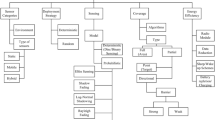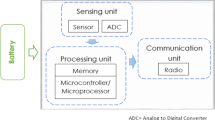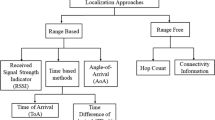Abstract
In wireless sensor and actuator networks, WSAN, actuators often act as cluster headers. Since the transmission range of actuator is much larger than that of sensor, both of the coverage of actuator and the connectivity of sensor-actuator require to be considered in the clustered WSAN. However, the existing clustering algorithms in WSAN only addressed the coverage issue. None of them considered the coverage and the connectivity jointly. Thus we proposed a K-hop coverage and connectivity aware clustering (K-CCAC) in this paper. The different sensor deployment models may affect the coverage and the connectivity for clustering. Thus K-CCAC was evaluated in five sensor deployment models we proposed. Simulation results demonstrated that the coverage and the connectivity in K-CCAC could be up to 100 % with fewer actuators in each model. The hop count from leaf sensors to cluster headers could be limited to K. Moreover, the number of actuators could decrease when the ratio of the transmission radius of actuator to that of sensor or the number of sensors increased.








Similar content being viewed by others
References
Akyildiz, I. F., & Kasimoglu, I. H. (2004). Wireless sensor and actuator networks: Research challenges. Ad Hoc Networks, 2(4), 351–367.
Munir, M. F. (2008). Wireless sensor and sensor-actuator networks: Research trends, protocols, and applications. In Proceedings of the IEEE conference on networking and communications, Lahore, p. 6.
Aslam, N., Phillips, W., Robertson, W., & Sivakumar, S. (2008). Extending network life by using mobile actors in cluster-based wireless sensor and actor networks. In Proceedings of the IFIP conference on wireless sensors and actor networks, Ontario, pp. 74–84.
Wark, T., Swain, D., Crossman, C., Valencia, P., Bishop-Hurley, G., & Handcock, R. (2009). Sensor and actuator networks: Protecting environmentally sensitive areas. IEEE Pervasive Computing, 8(1), 30–36.
Akkaya, K. & Younis, M. (2006). COLA: A coverage and latency aware actor placement for wireless sensor and actor networks. In Proceedings of the IEEE conference on vehicular technology, Montreal, pp. 1–5.
Akkaya, K. & Younis, M. (2007). C2AP: Coverage-aware and connectivity-constrained actuator positioning in wireless sensor and actuator networks. In Proceedings of the IEEE conference on performance computing and communications, New Orleans, pp. 281–288.
McLaughlan, B. & Akkaya, K. (2007). Coverage-based clustering of wireless sensor and actuator networks. In Proceedings of the international conference on pervasive services, Istanbul, pp. 45–54.
Akkaya, K., Senel, F., & McLaughlan, B. (2009). Clustering of wireless sensor and actuator networks based on sensor distribution and connectivity. Journal of Parallel and Distributed Computing, 69(6), 573–587.
Amis, A. D., Prakash, R., Vuong, T. H. P., & Huynh, D. H. (2000) Max-min d-cluster formation in wireless ad hoc networks. In Proceedings of the IEEE conference on computer communications, Israel, pp. 32–41.
Garcia, F., Solano, J., & Stojmenovic, I. (2003). Connectivity based k-hop clustering in wireless networks. Telecommunication Systems, 22(1–4), 205–220.
Akyildiz, I. F., Su, W., Sankarasubramaniam, Y., & Cayirci, E. (2002). Wireless sensor networks: A survey. Computer Networks, 38(4), 393–422.
Guo, P., Jiang, T., Zhang, K., & Chen, H.-H. (2009). Clustering algorithm in initialization of multi-hop wireless sensor networks. IEEE Transactions on Wireless Communications, 8(12), 5713–5717.
Verdone, R., Fabbri, F., & Buratti, C. (2010). Maximizing area throughput in clustered wireless sensor networks. IEEE Journal on Selected Areas in Communications, 28(7), 1200–1210.
Jiang, C., Yuan, D., & Zhao, T. (2009). Towards clustering algorithms in wireless sensor networks-a survey. In Proceedings of the IEEE conference on wireless communications and networking, USA, pp. 1–6.
Kumarawadu, P., Dechene, D. J., Luccini, M., & Sauer A. (2008). Algorithms for node clustering in wireless sensor networks: a survey. In Proceedings of the IEEE conference on information and automation for sustainability, Colombo, pp. 295–300.
Deosarkar, B. P., Yadav, N. S., & Yadav, R. B. (2008). Clusterhead selection in clustering algorithms for wireless sensor networks: A survey. In Proceedings of the IEEE conference on computing, communication and networking, St. Thomas, pp. 1–8.
Author information
Authors and Affiliations
Corresponding author
Rights and permissions
About this article
Cite this article
Wu, YC., Tuan, CC. K-Hop Coverage and Connectivity Aware Clustering in Different Sensor Deployment Models for Wireless Sensor and Actuator Networks. Wireless Pers Commun 85, 2565–2579 (2015). https://doi.org/10.1007/s11277-015-2920-2
Published:
Issue Date:
DOI: https://doi.org/10.1007/s11277-015-2920-2




